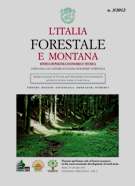Published
2012-07-03
Keywords
- forestry accounting,
- balance sheet,
- costs,
- IAS.
Abstract
In Italy the forest sector represents a controversial reality in the rural context. While the forest area covers almost one third of the national surface, the sector has a marginal economic role in the country. But, as stated in the EU Forestry Strategy and in Agenda 2000, forests can play an important role in maintaining a good social structure and improving the economic development of rural areas. The increase in the share of European financial budget dedicated to forestry measures in the Rural Development Plans gives evidence to this multifunctional role. As a consequence, in the last years there has been a growing interest in monitoring and evaluating the socio-economic effects of forestry measure, and consequently the demand for economic data on forestry sector has increased. In particular, the accounting results at farm level can be considered as a proxy of socio-economic indicators. INEA, responsible for the Italian Farm Accountancy Data Network (FADN) for agriculture, carried out the FADN survey at regional level using a software named GAIA, which structure follows the double entry bookkeeping scheme and includes the international accounting principles. In this work the results of a first application of the FADN accounting scheme to evaluate the profitability of a forest enterprise located in Veneto Region will be presented. Two different accounting schemes will be described: the traditional and the “forestry” one that computes also unrealized costs and revenues, generally not taken into account in the traditional schemes. The paper deals also about the main concerns of the forestry accounting.


